CSharpGL(18)分别处理glDrawArrays()和glDrawElements()两种方式下的拾取(ColorCodedPicking)
我在(Modern OpenGL用Shader拾取VBO内单一图元的思路和实现)记录了基于Color-Coded-Picking的拾取方法。
最近在整理CSharpGL时发现了一个问题:我只解决了用glDrawArrays();渲染时的拾取问题。如果是用glDrawElements();进行渲染,就会得到错误的图元。
本文就分别解决这两种情况下的拾取的问题。
下载
CSharpGL已在GitHub开源,欢迎对OpenGL有兴趣的同学加入(https://github.com/bitzhuwei/CSharpGL)
两种Index Buffer
ZeroIndexBuffer
用 glDrawArrays(uint mode, int first, int count); 进行渲染时,本质上是用这样一个(特殊索引+ glDrawElements(uint mode, int count, uint type, void* indices); )进行渲染:
uint[] index = { 0, 1, 2, 3, 4, 5, 6, 7, 8, … }
这个特殊索引的特点就是(i == index[i])且(index buffer的长度==position buffer的长度)。
所以我们可以把这个索引看做一个经过优化的VertexBufferObject(VBO)。优化的效果就是:此VBO占用的GPU内存空间(几乎)为零。所以我把这种索引buffer命名为ZeroIndexBuffer。
在之前的文章里,我拾取到了图元的最后一个顶点在position buffer里的索引值。由于index的特殊性质,position buffer前方(左侧)的连续几个顶点就属于拾取到的图元。所以glDrawArrays方式下的拾取问题就解决了。
像下面这个BigDipper的模型,是用glDrawArrays方式渲染的。其拾取功能完全正常。
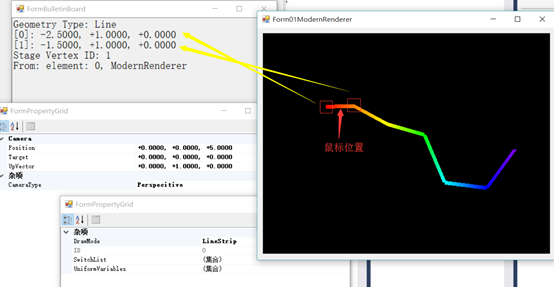
OneIndexBuffer
我把用glDrawElements进行渲染的index buffer命名为OneIndexBuffer。(因为实在想不出合适的名字了,就模仿一下编译原理里的0型文法、1型文法的命名方式)
lastVertexID
为便于说明,以下面的模型为例:

此模型描述了一个立方体,每个面都由4个顶点组成,共24个顶点。其索引(index buffer)用GL_TRIANGLES方式渲染,索引内容如上图如下:
index = { 0, 1, 2, 0, 2, 3, 4, 5, 6, 4, 6, 7, 8, 9, 10, 8, 10, 11, 12, 13, 14, 12, 14, 15, 16, 17, 18, 16, 18, 19, 20, 21, 22, 20, 22, 23 };
此index buffer的长度为36个uint(36*sizeof(uint)个字节)。
这个模型的position buffer长度(24)不等于index buffer的长度(36)。
所以,继续用上面的拾取方式,只能拾取到图元的最后一个顶点(此例为三角形的第3个顶点)在position buffer中的索引值。
假设拾取到的是第二个三角形,如下图所示,那么拾取到的图元的最后一个顶点在position buffer的索引值就是3。(此图只渲染了前2个三角形)
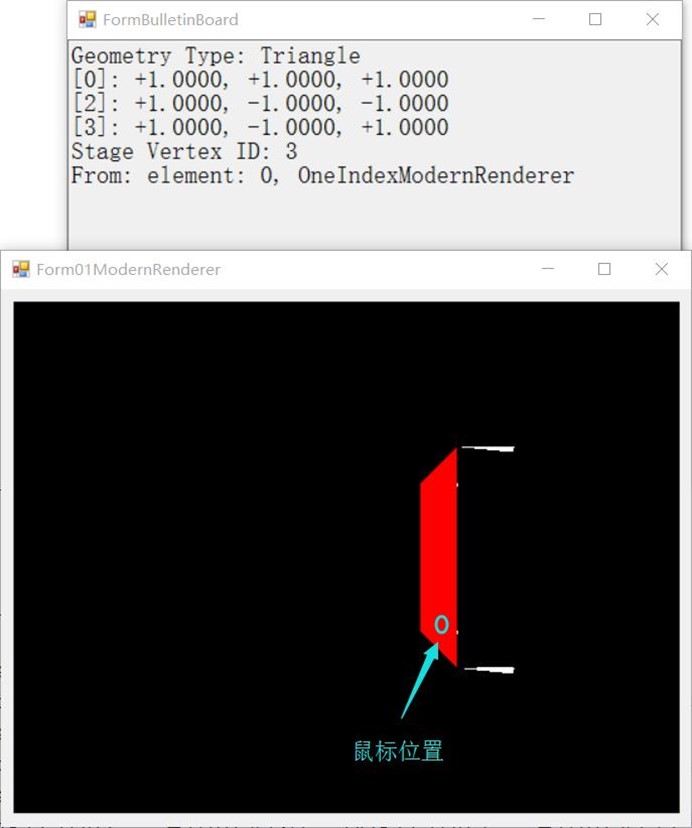
如果像之前那样,连续向前(向左)取3个顶点,就会得到position[1],position[2],position[3]。但是,如图所见,正确的3个顶点应该是position[0],position[2],position[3]。
就是说,由于index buffer内容是任意的,导致描述一个图元的各个顶点在position buffer中并非连续排列。
lastVertexID -> lastIndexIDList
继续这个例子,现在已经找到了lastVertexID为3。为了找到这个三角形所有的顶点,我们先在index buffer里找到内容为3的索引。
index = { 0, 1, 2, 0, 2, 3, 4, 5, 6, 4, 6, 7, 8, 9, 10, 8, 10, 11, 12, 13, 14, 12, 14, 15, 16, 17, 18, 16, 18, 19, 20, 21, 22, 20, 22, 23 };
只需遍历一下就会发现index[5] = 3。
所以,拾取到的三角形的三个顶点就是position[ index[5 – 2] ],position[ index[5 – 1] ],position[ index[5 – 0] ]。(index buffer中描述同一个图元的索引值是紧挨着排列的)
PrimitiveRecognizer
这个例子里,要识别的是三角形。实际上可能会识别点(Points)、线段(Lines、LineStrip、LineLoop)、四边形(Quads、QuadStrip)、多边形(Polygon)。所以我需用一个简单的工厂来提供各种PrimitiveRecognizer。
用于识别三角形的TriangleRecognizer如下:

1 class TrianglesRecognizer : PrimitiveRecognizer 2 { 3 public override List<RecognizedPrimitiveIndex> Recognize( 4 uint lastVertexID, IntPtr pointer, int length) 5 { 6 var lastIndexIDList = new List<RecognizedPrimitiveIndex>(); 7 unsafe 8 { 9 var array = (uint*)pointer.ToPointer(); 10 for (uint i = 2; i < length; i += 3) 11 { 12 if (array[i] == lastVertexID) 13 { 14 var item = new RecognizedPrimitiveIndex(lastVertexID); 15 item.IndexIDList.Add(array[i - 2]); 16 item.IndexIDList.Add(array[i - 1]); 17 item.IndexIDList.Add(array[i - 0]); 18 lastIndexIDList.Add(item); 19 } 20 } 21 } 22 23 return lastIndexIDList; 24 } 25 } 26 27 class RecognizedPrimitiveIndex 28 { 29 public RecognizedPrimitiveIndex(uint lastIndexID, params uint[] indexIDs) 30 { 31 this.LastIndexID = lastIndexID; 32 this.IndexIDList = new List<uint>(); 33 this.IndexIDList.AddRange(indexIDs); 34 } 35 36 public uint LastIndexID { get; set; } 37 38 public List<uint> IndexIDList { get; set; } 39 }
lastIndexIDList -> lastIndexID
这个例子里,只有一个index[5]=3。实际上可能会有多个index[i]=索引值。
所以要想办法从这些候选图元中找到真正拾取到的那个。
那么,什么时候会出现多个候选图元?就是这几个图元共享最后一个顶点的时候。例如下面的例子:在鼠标所在位置执行拾取时,会找到[0 1 3]、[0 2 3]和[1 2 3]这三组lastIndexID。
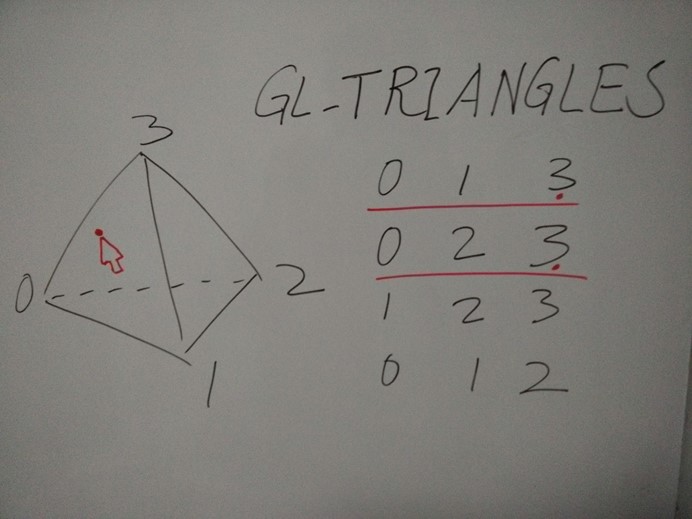
那么如何分辨出我们拾取到的是[0 1 3]而不是另2个?
我想到的方法是,将共享点前移,然后重新渲染、拾取。在这个例子里,就是把[0 1 3]和[0 2 3]变成[3 0 1]和[3 0 2],然后渲染[3 0 1 3 0 2]这个小小的index buffer(即仅渲染这2个图元)。这样是能够拾取到[3 0 1]的,这就排除了[3 0 2]。然后继续用同样的方法排除[1 2 3]。这就找到了[0 1 3]这个正确的目标。

1 /// <summary> 2 /// 在所有可能的图元(<see cref="lastVertexId"/>匹配)中, 3 /// 逐个测试,找到最接近摄像机的那个图元, 4 /// 返回此图元的最后一个索引在<see cref="indexBufferPtr"/>中的索引(位置)。 5 /// </summary> 6 /// <param name="lastIndexIdList"></param> 7 /// <returns></returns> 8 private RecognizedPrimitiveIndex GetLastIndexId( 9 ICamera camera, 10 List<RecognizedPrimitiveIndex> lastIndexIdList, 11 int x, int y, int canvasWidth, int canvasHeight) 12 { 13 if (lastIndexIdList.Count == 0) { throw new ArgumentException(); } 14 15 int current = 0; 16 foreach (var item in lastIndexIdList[0].IndexIdList) 17 { 18 if (item == uint.MaxValue) { throw new Exception(); } 19 } 20 for (int i = 1; i < lastIndexIdList.Count; i++) 21 { 22 foreach (var item in lastIndexIdList[i].IndexIdList) 23 { 24 if (item == uint.MaxValue) { throw new Exception(); } 25 } 26 OneIndexBufferPtr twoPrimitivesIndexBufferPtr; 27 uint lastIndex0, lastIndex1; 28 AssembleIndexBuffer( 29 lastIndexIdList[current], lastIndexIdList[i], this.indexBufferPtr.Mode, 30 out twoPrimitivesIndexBufferPtr, out lastIndex0, out lastIndex1); 31 uint pickedIndex = Pick(camera, twoPrimitivesIndexBufferPtr, x, y, canvasWidth, canvasHeight); 32 if (pickedIndex == lastIndex1) 33 { current = i; } 34 else if (pickedIndex == lastIndex0) 35 { /* nothing to do */} 36 else if (pickedIndex == uint.MaxValue) 37 { /* nothing to do */} 38 else 39 { throw new Exception("This should not happen!"); } 40 } 41 42 return lastIndexIdList[current]; 43 }
lastIndexID -> PickedGeometry
现在得到了图元的所有顶点在position buffer中的索引(上面的例子中,是[0 1 3]),只需一步就可以找到顶点了。(上面的例子中,是position[ index[0] ],position[ index[1] ],position[ index[3] ])

1 private PickedGeometry GetGeometry(RecognizedPrimitiveIndex lastIndexId, uint stageVertexId) 2 { 3 var pickedGeometry = new PickedGeometry(); 4 pickedGeometry.GeometryType = this.indexBufferPtr.Mode.ToPrimitiveMode().ToGeometryType(); 5 pickedGeometry.StageVertexId = stageVertexId; 6 pickedGeometry.From = this; 7 pickedGeometry.Indexes = lastIndexId.IndexIdList.ToArray(); 8 GL.BindBuffer(BufferTarget.ArrayBuffer, this.positionBufferPtr.BufferId); 9 IntPtr pointer = GL.MapBuffer(BufferTarget.ArrayBuffer, MapBufferAccess.ReadOnly); 10 unsafe 11 { 12 var array = (vec3*)pointer.ToPointer(); 13 List<vec3> list = new List<vec3>(); 14 for (int i = 0; i < lastIndexId.IndexIdList.Count; i++) 15 { 16 list.Add(array[lastIndexId.IndexIdList[i]]); 17 } 18 pickedGeometry.Positions = list.ToArray(); 19 } 20 GL.UnmapBuffer(BufferTarget.ArrayBuffer); 21 GL.BindBuffer(BufferTarget.ArrayBuffer, 0); 22 23 return pickedGeometry; 24 }
测试用例
ZeroIndexBuffer
这个情况属于早就解决了的,可以在(CSharpGL(17)重构CSharpGL)中查看。
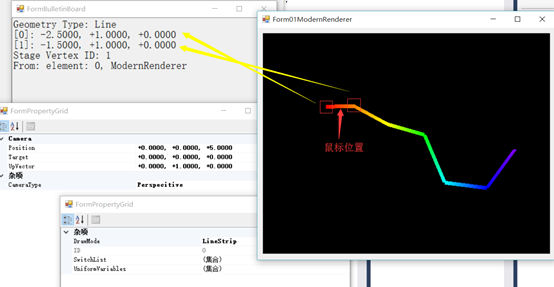
OneIndexBuffer
Cube
下图中的Cube模型就可以用来测试OneIndexBuffer的拾取功能。

下面12个测试用例测试了拾取CubeModel的12个三角形的情况。结果显示完全符合对Cube的定义。
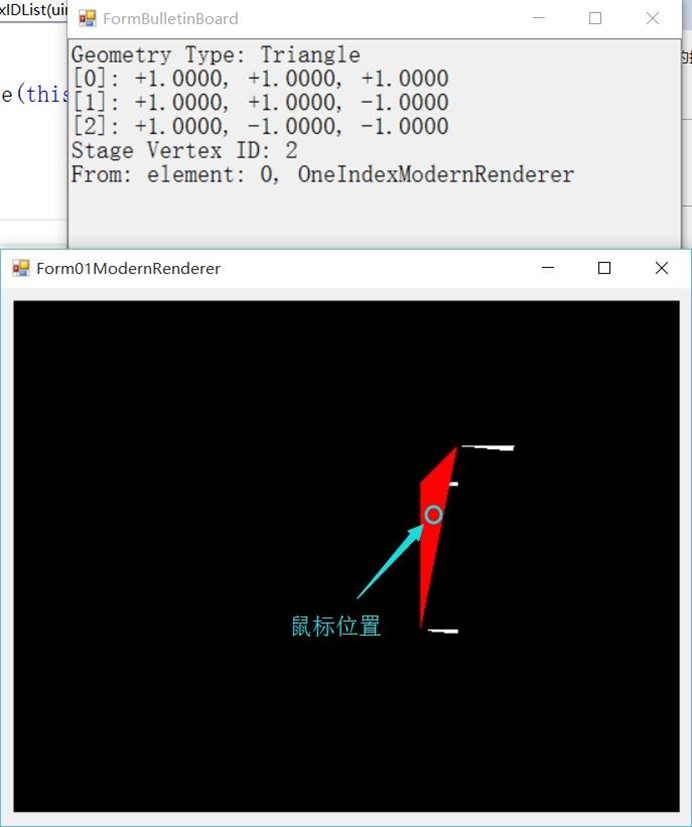


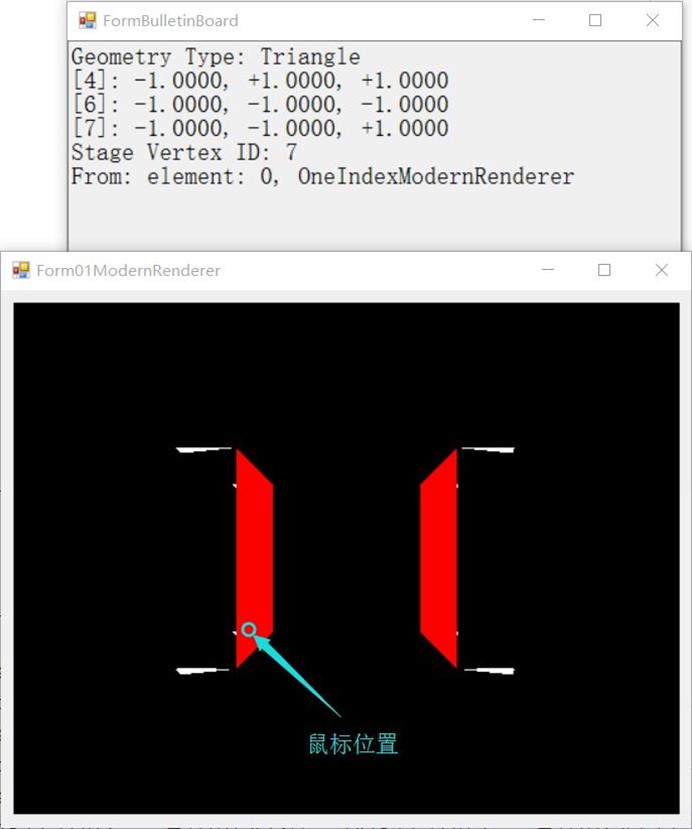
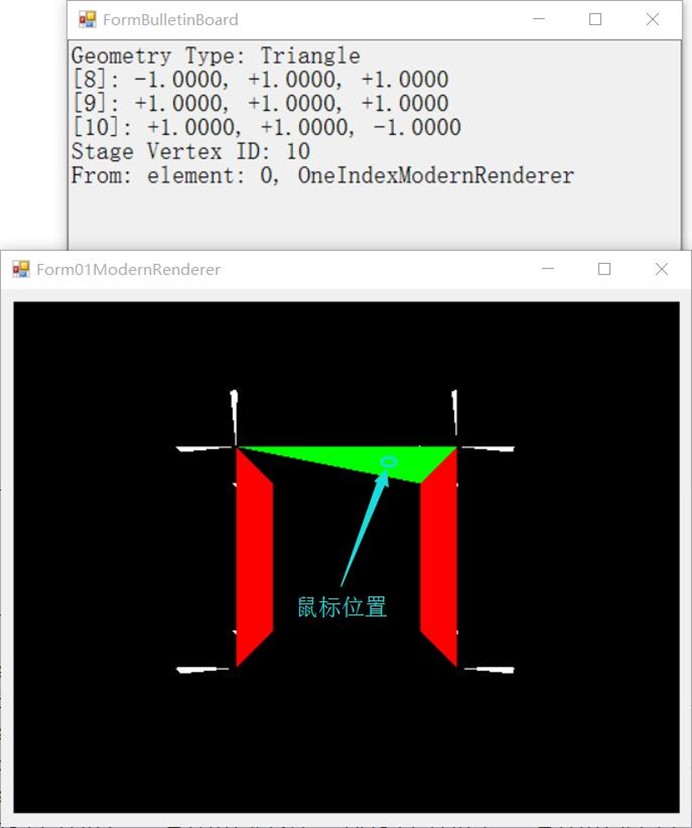
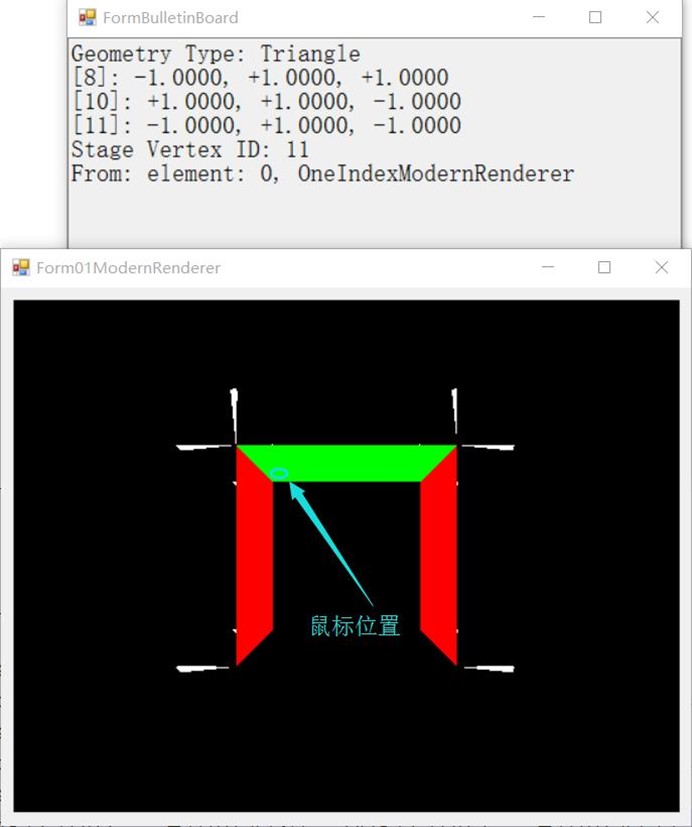

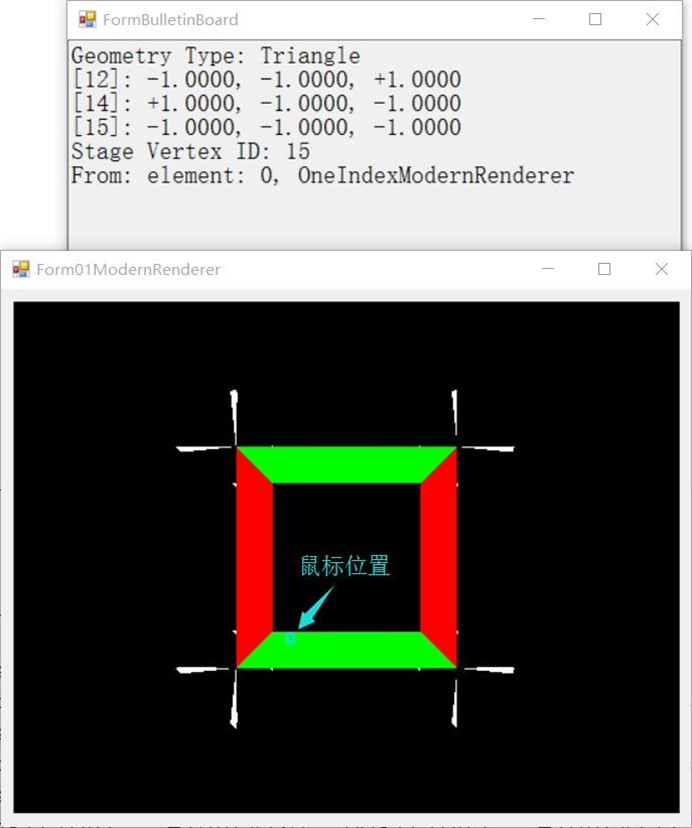

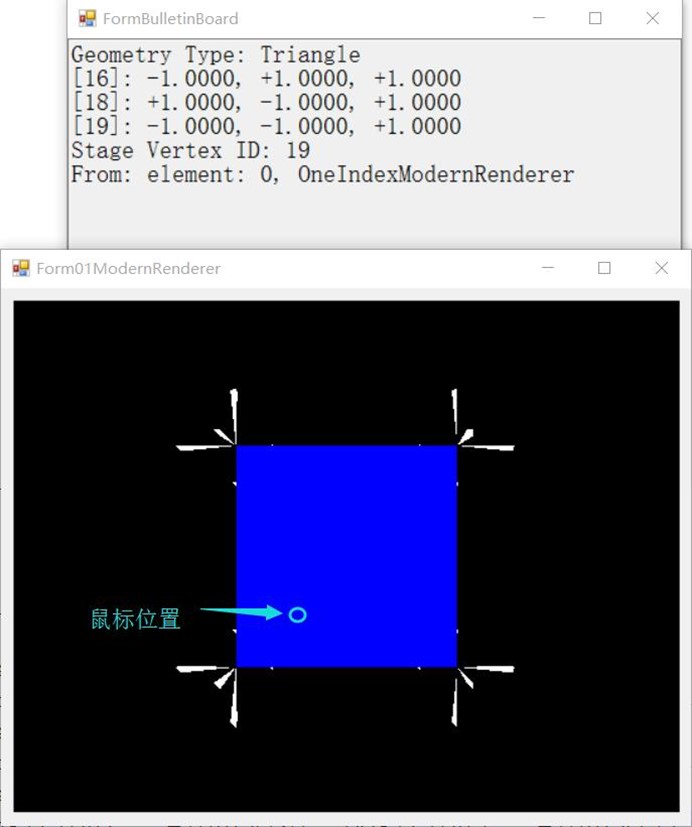
最后一个面在背面,所以需要旋转过来。
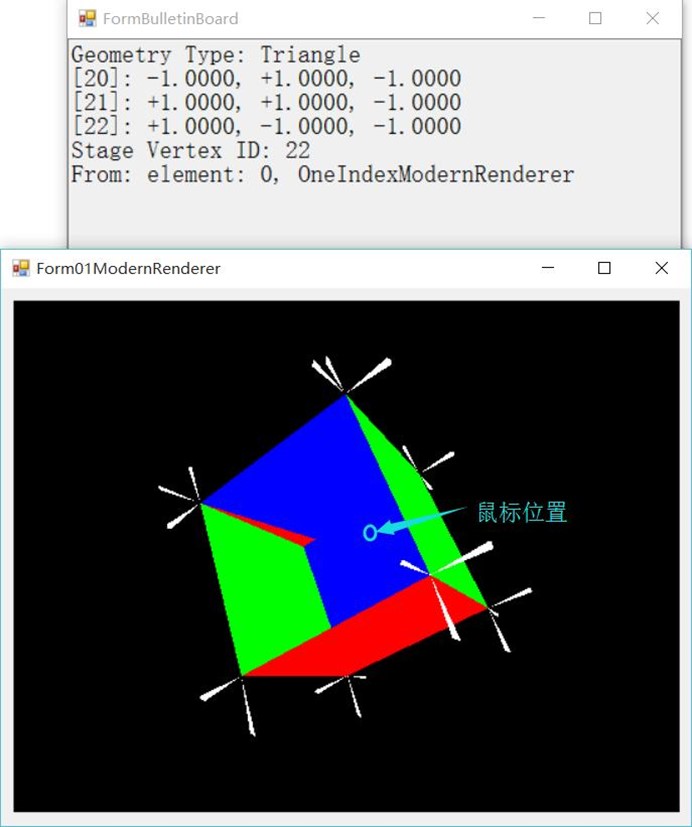
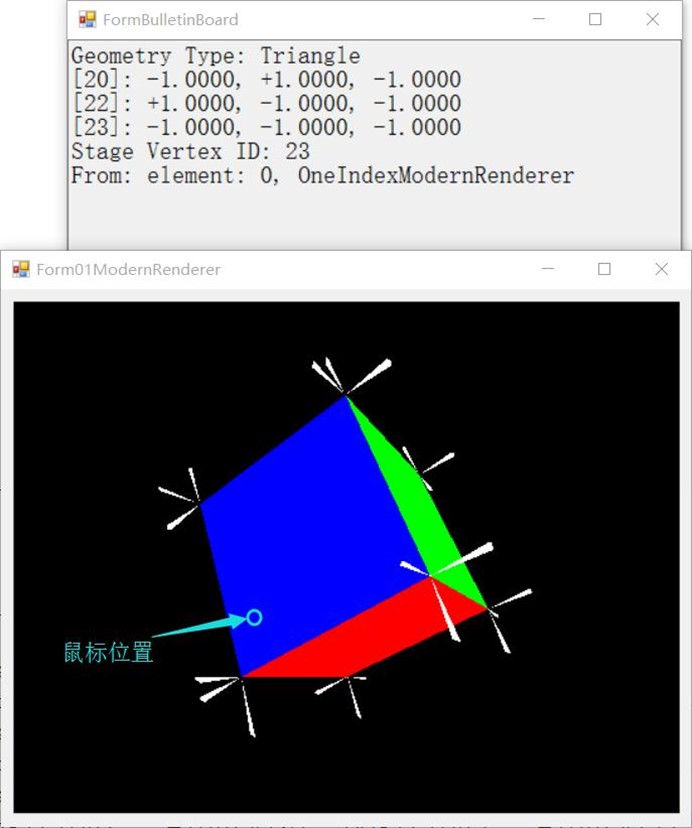
Sphere
当然,Cube是不足以完全测试OneIndexBuffer的拾取的。因为Cube里不存在共享最后一个顶点的情况。
Sphere里就有。
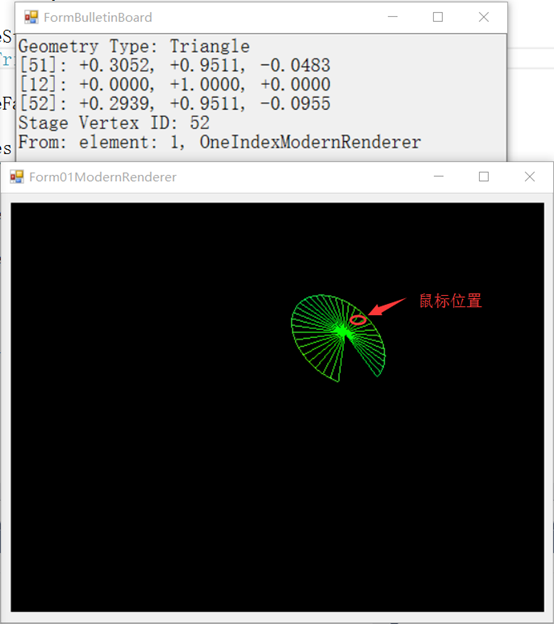

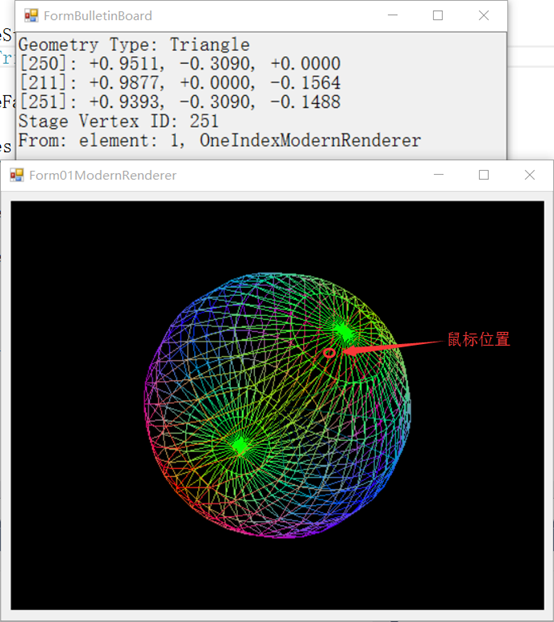
Teapot
Teapot的顶点组织方式我没有查看,权且充个数吧。

2016-04-26
为了严格测试OneIndexBuffer时存在“多个图元共享同一个最后的顶点”的情况,我制作了下面这个四边形模型。这验证了下图的情况。

Tetrahedron
根据上图,我设计了这样的模型数据:

首先看一下这个四边形的结构。通过设置GLSwitch里的PolygonModeSwtich为Lines,就可以看到这确实是个四边形。
(白色部分是geometry shader制造的法线,不必理会)
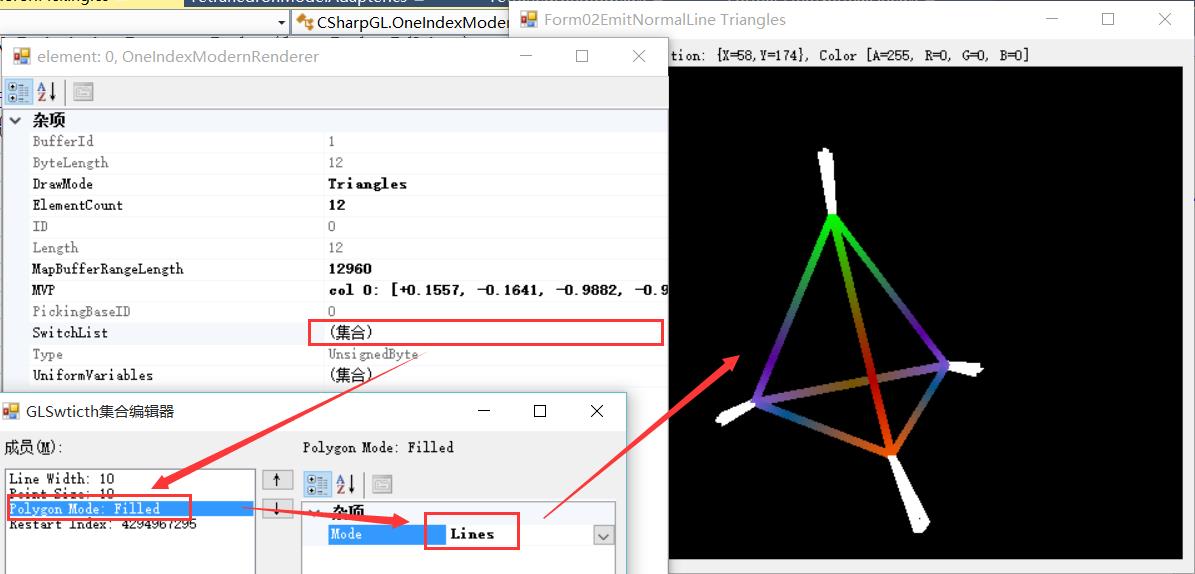
然后恢复到Filled模式下开始测试。下图中右边标明了各个顶点的索引(白色的0 1 2 3)。
可以看到这正是本文示例中描述的情况。结果完全符合预期。
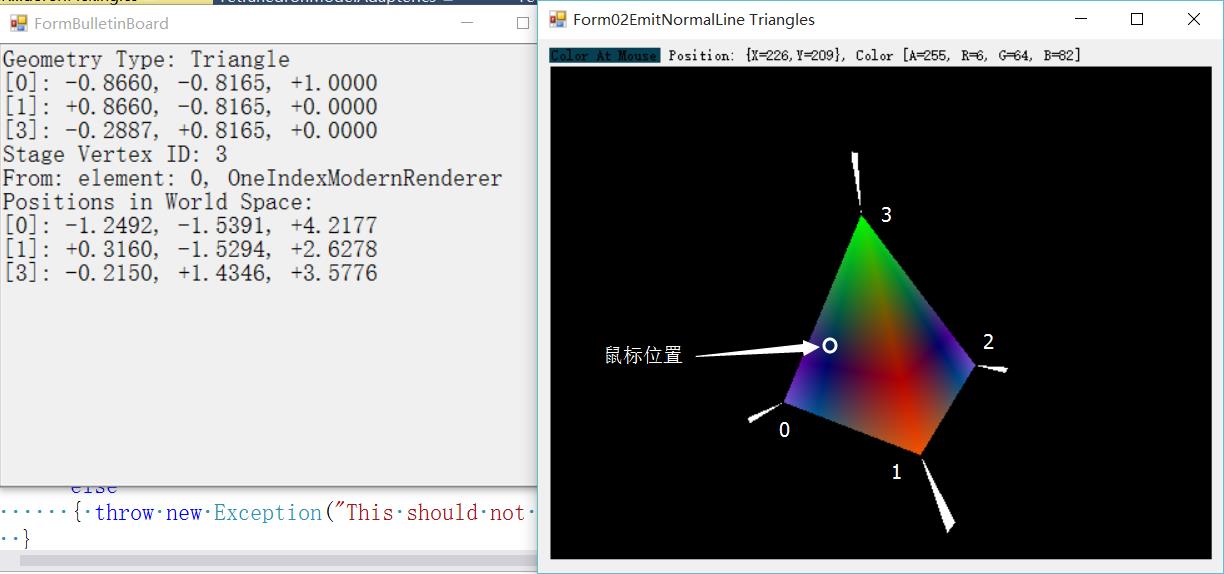
然后我们在其他位置都试试看。


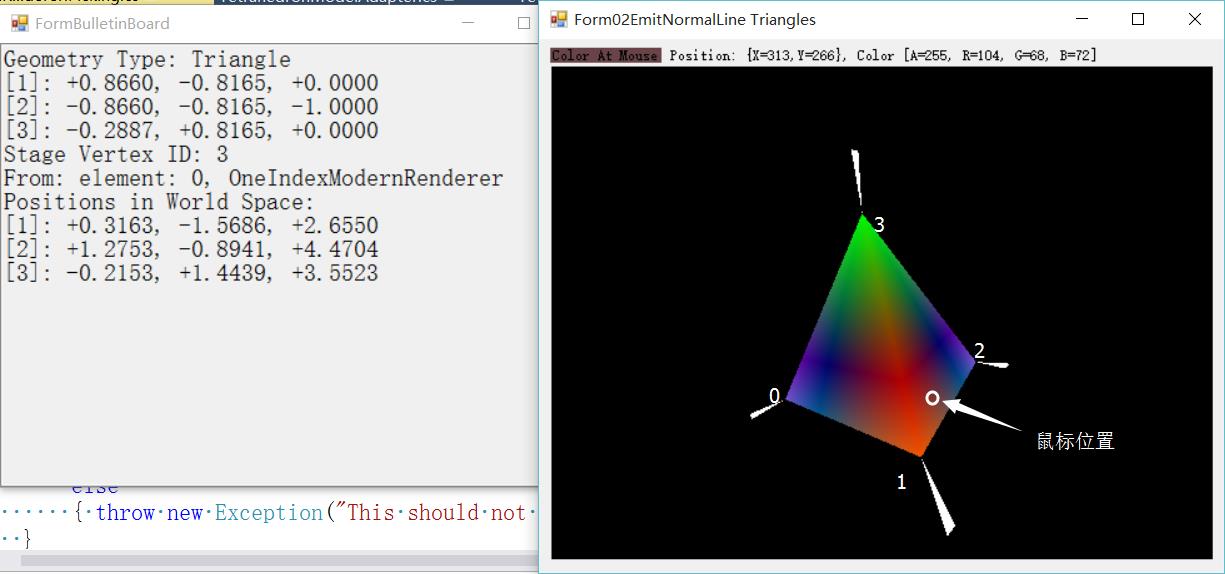
其余位置就不贴图了。
总结
解决拾取问题的过程也是整理ModernRenderer的过程。由于两种渲染方式的巨大差异,我设计了对应的ModernRenderer(即ZeroIndexModernRenderer和OneIndexModernRenderer)。再配合工厂模式,既封装了细节,实现了功能,又易于使用。
原CSharpGL的其他功能(UI、3ds解析器、TTF2Bmp、CSSL等),我将逐步加入新CSharpGL。
欢迎对OpenGL有兴趣的同学关注(https://github.com/bitzhuwei/CSharpGL)
